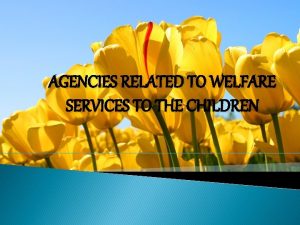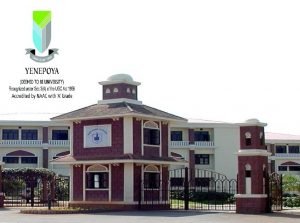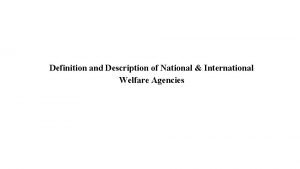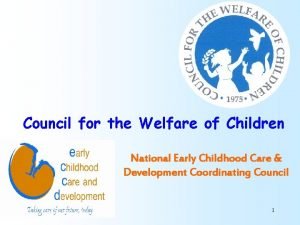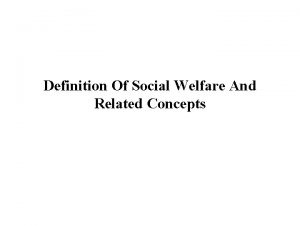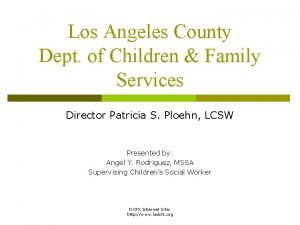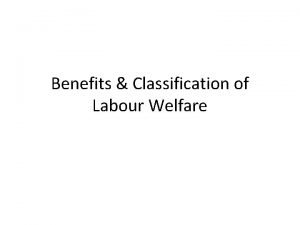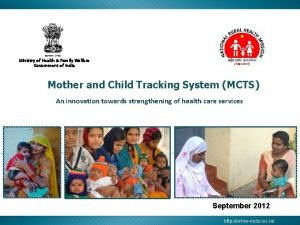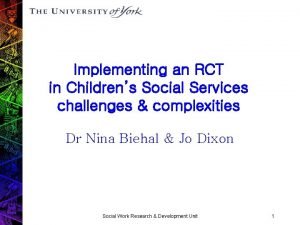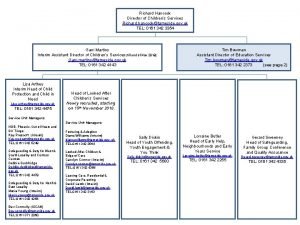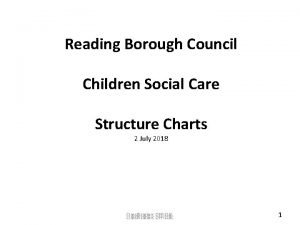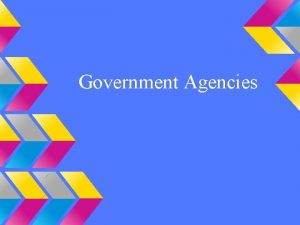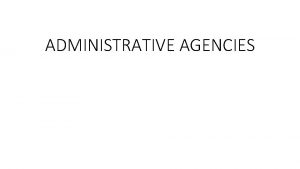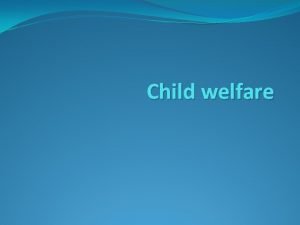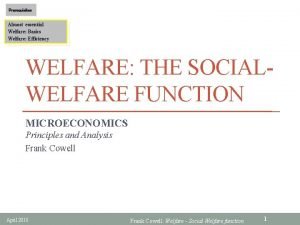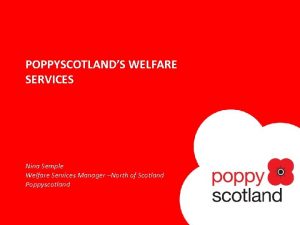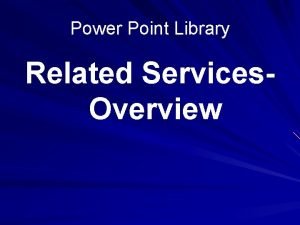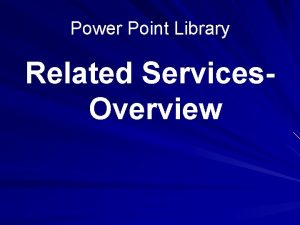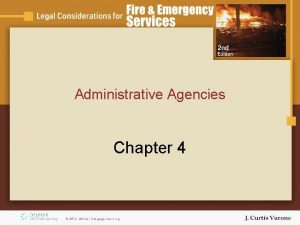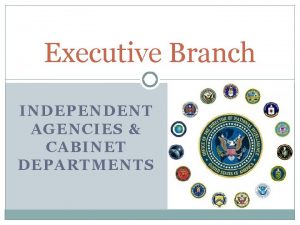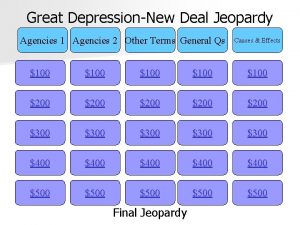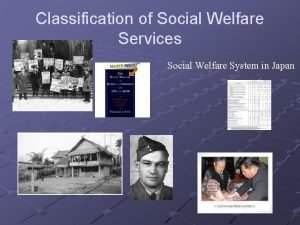AGENCIES RELATED TO WELFARE SERVICES TO THE CHILDREN























































- Slides: 55

AGENCIES RELATED TO WELFARE SERVICES TO THE CHILDREN

Child welfare, term used to refer to a broad range of social programmes that contribute to the well-being of children. A variety of child welfare service programs are conducted under public and private aspects. These can be categorized as support services, supplementary programmes, or substitute care.

I. INTERNATIONAL AGENCIES 1. WHO(WORLD HEALTH ORGANIZATION) WHO is a non-political, specialized health agency which has his head quarters in Geneva. It was established on 7 th April 1948. This day is celebrated as “World Health day”. Every year on April 7 th attention is focused on some topic of public health and attempts are made to achieve the target throughout the year.

OBJECTIVES The main objectives of WHO is the attainment of highest standards of health by all individuals. Currently the main objective of world health organization is “Health for all” through primary health care.

MEMBERSHIP During the foundation year 1948, its members numbered 56 which on first of January 1998 had reached 192. Two are its associate members.

ORGANIZATION STRUCTURE World Health Organization has three main wings: 1. World health assembly 2. Executive Board 3. Secretariat

FUNCTIONS OF WHO v Directing and coordinating health programs throughout the world. v Prevention and control of communicable and other specific diseases. v Helping the programs related to the improvement in the standards of family health.

v Promoting environmental health. v Collection of data for health statistics, communication and publication of information. v Encouraging research and strengthening the training institutes.

ACTIVITIES OF WHO IN INDIA The activities of WHO in India and south east Asia region are as follows: Ø Eradication of malaria Ø Control of tuberculosis and communicable diseases. Ø Health laboratory services. Ø Health statistics.

Ø Public health administration. Ø Reproductive and child health Ø Dental health. Ø Medical rehabilitation Ø Quality control of drugs. Ø Medical and Nursing education.

2. UNICEF(UNITED NATIONS INTERNATIONAL CHILDREN’S EMERGENCY FUND) UNICEF is a specialized agency of United Nations. It was established in the year 1946. for rehabilitation of world war effected children. In 1953, this was named as United Nations Children’s Fund, after the end of emergency operations. The headquarter of UNICEF is in New York and this is administered by an executive board of 30 nations.

Its main objective is improvement of the health of the mother and infants. UNICEF plays a main role in all programs which benefit the children’s health directly or indirectly. The regional headquarters of UNICEF is in Delhi which is called as south central Asia region(SCAR).

1. 2. 3. 4. 5. UNICEF helps in the following fields in India: Health Nutrition Education Water supply Social welfare

HEALTH ü Development of rural health services through � Help the primary health centers. � Control of communicable diseases � Immunization programs � Medical education and training.

NUTRITION v Applied nutrition program v Agricultural extension services v School health services v Helping dairy project v Prevention of malnutrition. v Provision of supplementary nutrition to children, supply of milk powder etc…

EDUCATION o Strengthening of science laboratories o Arranging workshops. o Supply of A. V. Aids. o Providing books and other education material to schools of nursing.

WATER SUPPLY v Digging wells in rural areas. v Promoting the use of ground water.

SOCIAL WELFARE ü Reproductive and child health services. ü Contributing to primary health care. ü Promoting child safety and safe motherhood.

3. CSSM(CHILD SURVIVAL AND SAFE MOTHERHOOD) Contribution for the achievement of “Health for all” Similarly UNICEF has formulated strategy called ‘GOBIFFF” encourage child health which can be explained below:

G-Growth chart to monitor the development in children. O-oral rehydration. B-Breast Feeding I-Immunization against six killer diseases. F-Family planning F-Food supplementation F-Female education

UNICEF is giving contribution to all the activities related to the protection and development of child health such as immunization, supplementary nutrition, growth monitoring, management of diarrhea, water supply, environment, sanitation, hygiene, child spacing, girl’s education and income, generation activities for women.

4. UNDP(UNITED NATIONS DEVELOPMENTAL PROGRAMME) It was established in 1966. It is the main source of funds for technical assistance the member countries- rich and poor of the united nations meet annually and pledge contribution to the UNDP.

OBJECTIVES The basic objective of the UNDP is to help the poorer nations develop their human and national resources more fully.

5. FAO(FOOD AND AGRICULTURE ORGANIZATION) The food and agriculture organization was formed in 1945 with headquarters in Rome. It was the first United Nations Organization specialized agency created to look after several areas of world cooperation.

AIMS OF FAO q To help the nations to raise the living standards. q To improve the nutritional status of the people of all countries. q To increase the efficiency of farming, forestry and fisheries. q To better the condition of rural people and through all these means to widen the opportunity of all people for productive work.

6. ILO(INTERNATIONAL LABOUR ORGANIZATION) The International Labour Organization was established as an affiliative League of the nations to improve the working and living conditions and the working population all over the world.

PURPOSE OF ILO q To contribute to the establishment of lasting peace by promoting social justice. q To improve the labour conditions and living standards. q To promote economic and social stability.

7. USAID(UNITED STATES AGENCY FOR INTERNATIONAL DEVELOPMENT) The USAID was created in 1961. It is in charge of activities previously administered by the technical cooperation mission (TCM). A USAID mission functions in New Delhi. US has been assisting in a member of projects designed to improve the health of India’s people.

Those are: v Eradication of malaria. v Medical education v Nursing education v Health education v Water supply and sanitation v Control of communicable diseases v Nutrition v Family planning.

8. THE COLOMBO PLAN At a meeting of the common wealth foreign minister at Colombo in January 1950, a program was drawn up for co-operative economic development in south and south east Asia. Colombo plan seeks to improve living standards of the people of the area by reviewing developmental plans and coordinating development assistance.

9. SIDA( SWEDISH INTERNATONAL DEVELOPMENT AGENCY) It is an international financing agency it has been providing financial assistance to the National Tuberculosis Program since 1979. The SIDA assistance is usually spent procurement of supplies like X-ray unit, microscopes, and anti tuberculosis drugs.

10. DANIDA( DANISH INTERNATIONAL DEVELOPMENT AGENCY) This is also a financing agency under the Govt. Denmark. It has been providing assistance for the services provided by the national blindness control program since 1978. they have now started extending their support for MCH programs in different parts of south India.

11. ROCK FELLER FOUNDATION The Rock Feller Foundation is a philanthropic organization started in 1913 and endowed by Mr. John. D. Rock feller. PURPOSE Its purpose is to promote the well-being of mankind throughout the world.

ACTIVITIES v They begin their work in India in 1920 and have contributed towards the training of competent teachers and research workers. v They are giving training for Indian candidates from abroad at the same time, they sponsoring travel charges and provided fellowship.

v Sponsoring visit of medical specialist from USA and providing grants to the selected institution.

12. FORD FOUNDATION It was another agency which was started as a contemporary of the Rock feller foundation. It concentrate on the development of rural health services and family planning through projects.

a) b) c) d) The FORD Foundation has helped to India in the following projects: Orientation training centers Research-cum-action projects. Pilot project in rural health services. Water supply and drainage scheme.

13. CARE(CO-OPERATIVE FOR AMERICAN RELIEF EVERY WHERE) It is a non governmental organization which was started in 1946. It began working in India in 1950. It has been helping with the school mid day meal scheme. Apart from this, it also provides help in the fields of medicine, literacy, vocational training and agriculture.

II. VOLUNTARY AGENCIES A voluntary health agency may be defined as an organization that is administered by an autonomous board which holds meetings, collects funds for its support chiefly from private sources and expends money, whether with or without paid workers, in conducting a programme directed primarily to furthering the public health by providing health services or health education, or by advancing of those activities.

FUNCTIONS q Supplementing the work of government agencies. q Pioneering q Education q Demonstration q Guarding the work of government q Advancing health legislation.

1. INDIAN RED CROSS SOCIETY Starting in 1920, there are now over 400 branches functioning in India. ACTIVITIES a)Relief work: Relief work at the time of food, war and disaster. Eg: collecting clothing and food for soldiers during war

b) Milk and medical supplies Indian red cross supplies milk powder and vitamin to hospitals, dispensaries, maternal and child welfare centers, schools and orphanages. c)Care of the sick and disabled soldiers The wounded jawans are great concern of Indian red cross. It runs a “red cross home” in Bangalore for the permanently disabled soldiers. This is well equipped hospital, and is the best of its kind in the far east

d) Maternal and child welfare services There are large member of maternity and child welfare centers all over India, either directly administered by affiliated to the red cross. e)Family planning several states in India are running family planning clinics under the spices of the Indian red cross.

f. Blood banks some of the state branches have started blood banks. The St. John ambulance association in India which is part of the red cross has trained several lakhs of men and women in first aid, home nursing and allied subjects.

2. HIND KUSHT NIVARAN SANGH The Hind Kusht Nivaran Sangh was founded in 1950 with its headquarters in New Delhi. ACTIVITIES q Rendering of financial assistance to various leprosy homes and clinics. q Health education through publication and posters. q Training of medical workers and physiotherapist.

3. INDIAN COUNCIL FOR CHILD WELFARE(ICCW) It was established in 1952 and it is affiliated to the International union for child welfare. AIMS To secure Indian children and those opportunities and facilities which are necessary to develop them physically, mentally, spiritually and socially in a healthy and normal manner.

4. TUBERCULOSIS ASSOCIATION OF INDIA The Tuberculosis Association Of India was formed in 1939. It has branches in all the states in India. ACTIVITIES I. Organizing a T. B seal campaign every year to raise funds. II. Training of doctors, health visitors and social workers in anti tuberculosis work. III. Promotion of health education and promotion of consultations and conferences.

5. BHARATH SEVAK SAMAJ This was formed in 1952, as a non – political, and non-official organization. The activities include camps such as youth camps, teaches training camps, college student’s camps and health publicity.

6. CENTRAL SOCIAL WELFARE BOARD It was started in 1953, as a semi government agency. ACTIVITIES q To provide service for mothers and children. q Social education for women. q Establishing balwadis for children and distribution of milk q Organizing play centers. q Providing maternity aid for women.

7. THE KASTURBAI MEMORIAL FUND Created in memory of Kasturba Gandhi, after the death in 1944. The fund was raised with the main object of improving the lot of women, especially in the villages through gram-sevikas.

8. FAMILY PLANNING ASSOCIATION OF INDIA It was established in 1949 with its headquarters in Mumbai. It has done initiative work in family planning in India. The association has trained several hundred doctors, health visitors and social workers.

9. ALL INDIA WOMENS CONFERENCE It is the only women’s voluntary welfare organization in the country established in 1926, It has now branches all over country. Most of the branches running M. C. H clinics, medical centers, adult education centers, milk centers and family planning clinics.

10. ALL INDIA BLIND RELIEF SOCIETY The all India blind relief society was established in 1946 with the view to coordinate different institution working for the blind. It organizes eye relief camps and other measures for the relief of the blind.

11. PROFESSIONAL BODIES Those bodies raise subscription through its members, hold conferences, publish journals, arrange scientific sessions, promote research and lay standards for professional organizations. Some of them are: **All India Medical Association **All India licentiates Association **The Trained Nurses Association of India.

 Child welfare agencies in india
Child welfare agencies in india National agencies for child welfare
National agencies for child welfare International welfare agencies
International welfare agencies National child health program
National child health program National policies related to child health and welfare
National policies related to child health and welfare Council for the welfare of children
Council for the welfare of children Physical fitness two types
Physical fitness two types Health related skill
Health related skill Social welfare services definition
Social welfare services definition Children and family services los angeles
Children and family services los angeles Classification of labour welfare
Classification of labour welfare Family welfare services introduction
Family welfare services introduction Rct children's services
Rct children's services Hampshire early years advisory team
Hampshire early years advisory team Lisa arthey
Lisa arthey Lorain county children services
Lorain county children services Reading borough council children's social services
Reading borough council children's social services Hát kết hợp bộ gõ cơ thể
Hát kết hợp bộ gõ cơ thể Slidetodoc
Slidetodoc Bổ thể
Bổ thể Tỉ lệ cơ thể trẻ em
Tỉ lệ cơ thể trẻ em Voi kéo gỗ như thế nào
Voi kéo gỗ như thế nào Tư thế worms-breton
Tư thế worms-breton Chúa yêu trần thế
Chúa yêu trần thế Môn thể thao bắt đầu bằng từ đua
Môn thể thao bắt đầu bằng từ đua Thế nào là hệ số cao nhất
Thế nào là hệ số cao nhất Các châu lục và đại dương trên thế giới
Các châu lục và đại dương trên thế giới Công thức tính thế năng
Công thức tính thế năng Trời xanh đây là của chúng ta thể thơ
Trời xanh đây là của chúng ta thể thơ Mật thư tọa độ 5x5
Mật thư tọa độ 5x5 Làm thế nào để 102-1=99
Làm thế nào để 102-1=99 Phản ứng thế ankan
Phản ứng thế ankan Các châu lục và đại dương trên thế giới
Các châu lục và đại dương trên thế giới Thể thơ truyền thống
Thể thơ truyền thống Quá trình desamine hóa có thể tạo ra
Quá trình desamine hóa có thể tạo ra Một số thể thơ truyền thống
Một số thể thơ truyền thống Cái miệng nó xinh thế
Cái miệng nó xinh thế Vẽ hình chiếu vuông góc của vật thể sau
Vẽ hình chiếu vuông góc của vật thể sau Thế nào là sự mỏi cơ
Thế nào là sự mỏi cơ đặc điểm cơ thể của người tối cổ
đặc điểm cơ thể của người tối cổ Thế nào là giọng cùng tên
Thế nào là giọng cùng tên Vẽ hình chiếu đứng bằng cạnh của vật thể
Vẽ hình chiếu đứng bằng cạnh của vật thể Phối cảnh
Phối cảnh Thẻ vin
Thẻ vin đại từ thay thế
đại từ thay thế điện thế nghỉ
điện thế nghỉ Tư thế ngồi viết
Tư thế ngồi viết Diễn thế sinh thái là
Diễn thế sinh thái là Dạng đột biến một nhiễm là
Dạng đột biến một nhiễm là Số nguyên là gì
Số nguyên là gì Tư thế ngồi viết
Tư thế ngồi viết Lời thề hippocrates
Lời thề hippocrates Thiếu nhi thế giới liên hoan
Thiếu nhi thế giới liên hoan ưu thế lai là gì
ưu thế lai là gì Khi nào hổ mẹ dạy hổ con săn mồi
Khi nào hổ mẹ dạy hổ con săn mồi Khi nào hổ mẹ dạy hổ con săn mồi
Khi nào hổ mẹ dạy hổ con săn mồi
